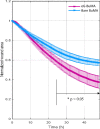eG Coated Stents Exhibit Enhanced Endothelial Wound Healing Characteristics
- PMID: 34008078
- PMCID: PMC8481217
- DOI: 10.1007/s13239-021-00542-x
eG Coated Stents Exhibit Enhanced Endothelial Wound Healing Characteristics
Abstract
Purpose: Despite their widespread use, a significant fraction of coronary stents suffer from in-stent restenosis and stent thrombosis. Stent deployment induces extensive injury to the vascular endothelium. Rapid endothelial wound closure is essential for the success of a stenting procedure. A recent study has demonstrated that the BuMA Supreme® sirolimus-eluting stent exhibits particularly attractive strut coverage characteristics. A unique feature of this stent is the presence of a thin brush layer of poly-butyl methacrylate (PBMA), covalently bonded to the stent's cobalt-chromium frame via electro-grafting (eG™). The present study aimed to determine whether the PBMA coating has an effect on endothelial cell wound healing and stent strut coverage.
Methods: We used an in vitro coronary artery model whose wall consisted of an annular collagen hydrogel and whose luminal surface was lined with a monolayer of endothelial cells. Mechanical wounding of the endothelial lining was preformed prior to deployment of a bare cobalt-chromium stent either with or without the PBMA layer. The migration of fluorescently labeled endothelial cells was monitored automatically over a period of 48 h to determine endothelial wound healing rates.
Results: Quantitative assessment of endothelial wound healing rates within the simulated arterial model is achievable using automated image analysis. Wound healing is significantly faster (44% faster at 48 h) for stents with the PBMA eG Coating™ compared to bare metal stents.
Conclusion: The PBMA eG Coating™ has the effect of promoting endothelial wound healing. Future studies will focus on elucidating the mechanistic basis of this observation.
Keywords: Automated image analysis; BuMA; Polymer brush coating; Simulated arterial model; Stent; Wound healing.
© 2021. The Author(s).
Figures







Similar articles
-
A randomised comparison of healing response between the BuMA Supreme stent and the XIENCE stent at one-month and two-month follow-up: PIONEER-II OCT randomised controlled trial.EuroIntervention. 2018 Dec 20;14(12):e1306-e1315. doi: 10.4244/EIJ-D-18-00461. EuroIntervention. 2018. PMID: 30082261 Clinical Trial.
-
Comparative preclinical evaluation of a polymer-free sirolimus-eluting stent in porcine coronary arteries.Ther Adv Cardiovasc Dis. 2019 Jan-Dec;13:1753944719826335. doi: 10.1177/1753944719826335. Ther Adv Cardiovasc Dis. 2019. PMID: 30803407 Free PMC article.
-
A prospective, multicenter, randomized OCT study of early neointimal condition at first and second months after BuMA Supreme stent versus XIENCE stent implantation in high-bleeding-risk coronary artery disease patients: study protocol for a randomized controlled trial.Trials. 2019 Jun 7;20(1):335. doi: 10.1186/s13063-019-3361-0. Trials. 2019. PMID: 31174600 Free PMC article.
-
Drug-eluting stents.Arch Cardiol Mex. 2006 Jul-Sep;76(3):297-319. Arch Cardiol Mex. 2006. PMID: 17091802 Review.
-
Stent thrombosis with drug-eluting stents: is the paradigm shifting?J Am Coll Cardiol. 2013 Nov 19;62(21):1915-1921. doi: 10.1016/j.jacc.2013.08.725. Epub 2013 Sep 11. J Am Coll Cardiol. 2013. PMID: 24036025 Review.
Cited by
-
Hemocompatibility of all-trans retinoic acid-loaded citrate polymer coatings for vascular stents.Regen Eng Transl Med. 2022 Dec;8(4):579-592. doi: 10.1007/s40883-022-00257-y. Epub 2022 May 2. Regen Eng Transl Med. 2022. PMID: 36714809 Free PMC article.
References
Publication types
MeSH terms
Substances
LinkOut - more resources
Full Text Sources
Other Literature Sources

